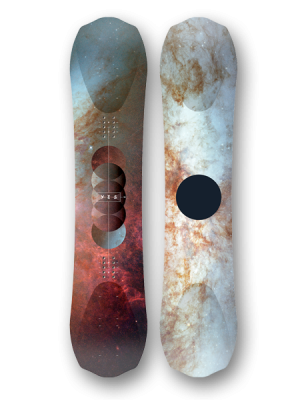The 20/20 150
Product.Nr.: 642-150EUR 649,00 incl. 19 % VAT excl. shipping costs
boardsize:
 Shipping within 24 hours
Shipping within 24 hours

All products from YES.
Manufacturer Website
product description
SnowboardThe 20/20
YES
Powder Twin Board from YES
While filming for Absinthe in Jackson Hole last winter, Romain and
Austen spelled out their demands for a board that could ride powder as
well as the 420 does, but in a twin configuration that would float that
well in either direction.
This began an intense design and development
path that led us to one of the most mind-bending boards you’ll ever see.
The outline is unique.
A wide, short twin with nose and tail shapes
that look more like a wake or kiteboard than a snowboard.
But tilt that 2
dimensional view and you see why it’s the 3D perspective that really
defines this board.
Deep, pronounced concaves dominate both ends of the
base and are the secret to its twin floatation prowess.
On hard-pack it’s
just a short, wide, super fun twin.
Austen. Romain. The ball is in your
court.
Board Features:
- RIDERS: Early Adopters, Futurists
- LENGTHS: 146, 150
- SHAPE: True Twin
- OUTLINE: Radial
- FLEX: 4/5
- BASE PROFILE: Powderhull
- CORE: Weightless Core
- GLASS: Triax
- BASE MATERIAL: Sintered True
| size: | 150cm | |
| shape: | true twin | |
| special: | 3D Powder Hull | |
| terrain: | freestyle/powder | |
| rider level: | advanced/expert | |
| flex: (1=soft/10=hard) | 7 | |
| effective edge: | 107cm | |
| nose width: | 32,31cm | |
| tail width: | 32,31cm | |
| waist: | 27,8cm | |
| setback: | 0cm | |
| sidecut: | n.a. |
3D POWDER HULL
The 3D Powder Hull starts with a base profile that combines 2 distinct rocker lines that, when blended together, create a pronounced base concave in the nose and tail.The centerline is fully rockered starting from the insert packs, all the way to the tips of the bluntly shaped nose and tail. Out at the contact edges, is a more conventional base profile that we use on many of our other boards. The resultant concave across the nose and tail acts differently at the leading end of the board than it does at the trailing end when riding in deep snow.
At the leading end (nose), the concave draws air under the board – just as a concave spoon-nose does on longboards in the surf – causing lift and floatation.
As the snow moves across the base it releases off the tail and the exaggerated rocker line along the center, causes the tail to drop downward.
So even though it’s a perfectly balanced twin, the board rides through deep snow with the same pitch, or planing angle, that we get with directional shapes and set-back stances.
On hard-pack it’s just a short, wide, super fun twin.




